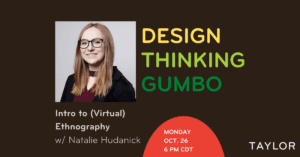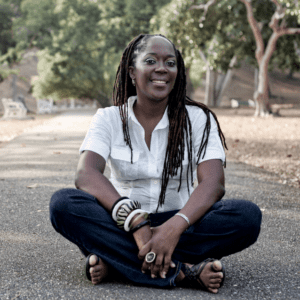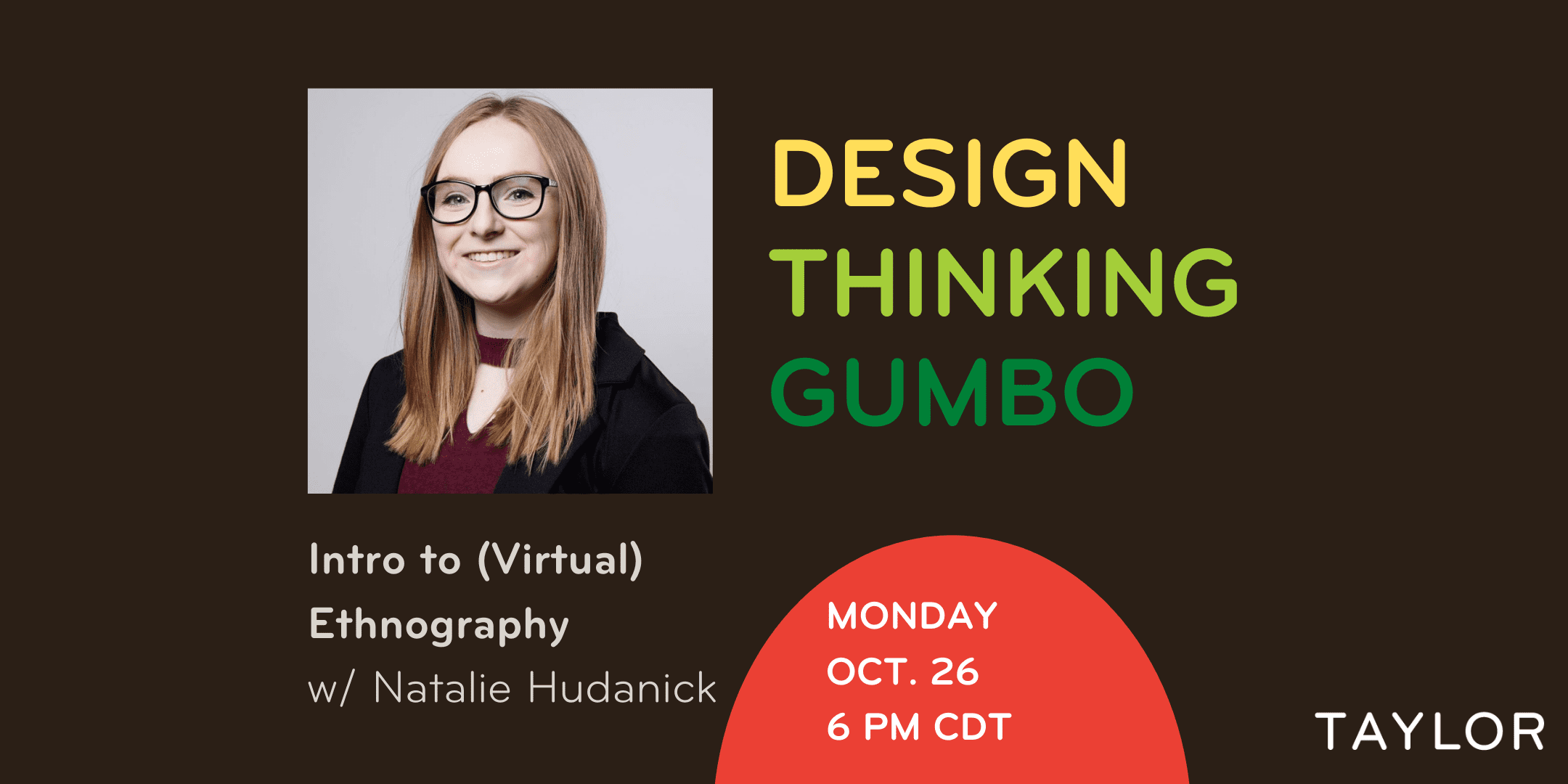
On October 26 2020, Intro to (Virtual) Ethnography with Natalie Hudanick demonstrated how to use ethnography and ethnographic tools in a virtual and remote setting. The goal of this workshop was to learn how to use these tools to understand how people have been living, feeling, and behaving during the pandemic.
Overview
With a brief lecture on ethnography, ethnography in design thinking, and its tools, participant observation, interviews, surveys, and archival research, participants were given the background knowledge needed to understand ethnography and how we can adapt to this new, remote, and virtual world. Two activities were completed by participants to learn how to apply observation and interview skills in a remote way.
- For the first activity, participants observed photographs, submitted by other participants, in groups to infer and create themes around how people’s living spaces have been impacted by the Covid-19 pandemic.
- In the second activity, participants, in groups, worked on interviewing and observing each other to apply remote interview skills and ultimately learn more from each other about the Covid-19 pandemic.
- Intro to Virtual Ethnography closed on an important note about the importance of human connection when utilizing ethnography remotely, and how we, those who use ethnography, need to learn how to develop rapport and empathy to truly understand how people are living.
About the Presenters

Lesley-Ann Noel, Ph.D. is an Afro-Trinidadian design educator, based in New Orleans. In my work, I focus on equity, social justice and the experiences of people who are often excluded from design research. My doctoral research focused on emancipatory design thinking at a rural primary school in Trinidad and Tobago. I also attempt to promote a greater critical awareness among designers and design students. Deep empathy is a key theme in my classes, where students build relationships across difference before collaborating on design with community partners. My research also highlights the work of designers outside of Europe and North America. My identity is shaped by my ethnic background as an Afro-Trinidadian; my experience as a daughter, sister and mother; and my lived experiences in Trinidad and Tobago, Brazil, Tanzania, Uganda and the USA.

Natalie Hudanick is a Graduate Assistant in Design Thinking for Social Impact at the Phyllis M. Taylor Center. She is also is a second-year MPH candidate in Maternal and Child Health at Tulane University School of Public Health and Tropical Medicine. Natalie earned a Bachelor of Science in Cultural Anthropology from Ball State University in Muncie, Indiana. With a background in anthropology and women’s health, her research interests lie in reproductive health and health communication.
Workshop Information
Workshop Recording
Transcript
Lesley-Ann Noel, Ph.D.: Hello everyone, welcome you all to the first in the series of Design Thinking Gumbo, a series where we share with you a delicious mix of design research tools and methods, to help you expand your taste for design thinking and design research. I am Lesley-Ann Noel, and I’m the Associate Director of Design Thinking for Social Impact of the PhyllisM.TaylorCenter for Social Innovation and Design Thinking. DT Gumbo is led by our design thinking graduate assistants. We will have 5 research workshops over the next few weeks. We’ll post all of the registration links in the chat, but the next workshop is about Using poetry in design research and it will happen on Nov 9th,
so now I’d love to hand over to our graduate assistant who will lead us today, Natalie Hudanick
Natalie Hudanick: Hi Everyone! My name is Natalie Hudanick and I am a graduate assistant for design thinking for social impact here at the Taylor Center. I am also second year Master of Public Health candidate at Tulane’s School of Public Health and Tropical Medicine.
What’s the session about?
Natalie: The Covid-19 pandemic has created the unique opportunity to explore the application of design thinking methods in a remote and virtual way. This Design Thinking Gumbo session will explore the method of ethnography and how to apply it virtually to understand people’s experience of the Covid-19 pandemic. I do want to let everyone know that this session will be recorded and we will be taking screenshots to feature on the Taylor Center website.
Warm Up:
Natalie: I’d like for us to warm up today by just sharing one word that describes how you are feeling at the moment. Just unmute yourself and say one word to describe how you are feeling at this very moment? Or you can always drop in the chat box one word to describe your feeling! It’s okay if we talk over each other too! Some feelings I heard….
Lecture on Ethnography:
Natalie: We are first going to go over what ethnography is and who typically uses this method. Ethnography is, by definition, the systematic study of culture. Another way to think of ethnography though, that is considered more relevant to design thinking, would be to define ethnography as ways to see how people make sense of the world in everyday life; how do people go about their life, and how do they interact with their environment.
Natalie: One of the main disciplines in which ethnography is the primary method for research is anthropology. In Anthropology, ethnographic fieldwork uses the various tools within in ethnography to research other ways of life, knowing. While ethnography is typically known for its use in the social sciences, it can ultimately be used by anyone who wants to research groups of people, cultures, and life.
Lesley: Natalie, now what are some tools that we could use within Ethnography?
Natalie: There are four main tools within Ethnography to collect qualitative information: Participant observation, interviews, surveys, and archival research. To start, participant observation is typically the method most associated with ethnography as it is requires you to gather research by actively participating and incorporating yourself into the group of people, culture, or environment you are studying. Participant observation typically forms a continuum ranging from completely removed from what you are researching (Complete observer) to completely involved as a participant (complete participant).
Interviews are common tools used within in ethnographic research, and are most often used in conjunction with participant observation. There are three types of interviews: Structured, semi-structured, and unstructured. Structured interviews are when you develop a questionnaire and then you only follow the questionnaire throughout the interview. Semi-structured interviews have guided questions that you would like to have answered, but it is not really strict on whether the interview has to follow those questions exactly. It can still be somewhat of a conversation between the interviewer and the interviewee. Unstructured interviews (or informal interviews) are when there are no questions laid out. It is essentially a conversation, sometimes recorded, sometimes not. Most often unstructured interviews can get you the richest information, as it takes a way a bit of the strictness of questionnaires and is just about having a conversation with your participant/informant.
Surveys are another tool of ethnography that are very similar to structured surveys. Surveys are typically about quickly collecting data, like demographic information or quick answers. The questions are all laid out, usually with options for participants to pick from for their answer.
Archival research is the one last tool of ethnography. Typically archival research involves looking at past documents, materials, records, etc. of the group being researched. It can be used to learn about cultures of the past/people of the past or when used along with surveys, interviews, and participant observation, archival research can help to form a more thorough picture of the group.
Natalie: Ethnography can be a great tool for Design Thinking. It can be used to study the relationships, interactions, environments between the user and the issue. Lesley, as a design thinker, how do you think Ethnography can be employed in design thinking?
Lesley: Design thinking and ethnography…..
Natalie: Critical ethnography is a lens in which to apply to the method within Design Thinking. It is about challenging the established practice of ethnography, and in doing so understanding that there is no objectivity or neutral observer in using this method.
Lesley: How do you think ethnography been impacted by Covid-19?
How can we use these tools during the pandemic? And how we can use them to understand the pandemic?
Niesha will you please make the breakout rooms?
Natalie: The Covid-19 pandemic has created a unique challenge in which to apply ethnography. With everyone remote, we need to think of more creative ways to use ethnography to understand how people make sense of their environment. So how do we use ethnography remotely to understand the pandemic? Some of these new opportunities allow for more acknowledgement of subjectivity within ethnographic research, what you see virtually is what your participant/informant wants you to see, most often through their video backgrounds. Interviews may also not be as convenient as they have been in the past. Interviewees might not be in the “perfect” environment at the time to complete an interview (they could be driving, cooking, taking care of children, etc.). The imperfectness that may arise from virtual research can possibly allow for a better look into the lives of people. These are the things we are going to be looking at as to how to utilize ethnography to understand how people are understanding and living during the Covid-19 pandemic.
Natalie: Our activities today will be about exploring observations and qualitative style interviews in a virtual setting, what we can make of these observations, and specifically how it relates to Covid-19.
Activity:
Natalie: When you registered for this workshop, we had all of you submit a photograph of something in your immediate vicinity that has been impacted by the Covid-19 pandemic along with a reflection about the photo. These photographs will help us look at how we can do “virtual” ethnography through observations to possibly understand how people have been handling the pandemic. All the photos and reflections were put together onto a google slide deck and we are going to drop the link to the slide deck in the chat box for all of you to see all the submissions to use during this activity. I’m going to put you all now into breakout rooms and in each of these breakout rooms, I would like you to observe the photograph that goes with your breakout room. Each photograph is numbered and will correspond directly with your breakout room number. Along with your initial observations of the photo, 3 guiding questions to use in your breakout rooms are: “What do you see?”, “What does the photograph tell you?”, and “From the given photograph, how do you think the person is handling the Covid-19 pandemic?”. Keep in mind as I send you into your breakout, you will be reporting out your thoughts and observations when you come back.
Debrief:
Natalie: So I just wanted to debrief a bit about the activity. What were some themes we can pull out from these photographs? How did you all go about observations? What can this type of observational method tell us about Covid-19. I’d like at least one person from each break out room to report some of the thoughts they had. Those who aren’t speaking can also put in the chat some thoughts. Breakout Room 1, what were some thoughts your group had?……
Activity 2:
Natalie: The observations we just looked at tell only one side of someone’s pandemic experience. Interviews can help to explore those other sides helping to complete a more complete picture. Now using interviewing as an ethnographic tool is a bit different than it has been normally, as they might normally take place in person in the best setting for both the interviewee and the interviewer. For formal interviews, like job interviews, most often there is rigid rules to be as professional as possible. But when we are interviewing for qualitative research, these rules aren’t so rigid. For this next activity, I’m first going to go over some tips for interviewing during Covid-19 and then send you into breakout rooms to explore these tips through the use of interviews.
Natalie: Tips for interviewing for qualitative research in any capacity, especially to understand their experiences within the pandemic, need to be fluid as everything could change throughout the interview. When you’re forming questions, keep them open-ended and not as structured. A semi-structured interview format, with guiding questions, or even an unstructured interview format could be very useful interview types to use in video calls, as it allows for a more fluid conversation to happen. Another tip is to really utilize your video background. Your video background is a reflection of you, your environment, and your existence at that very moment. If both you and your interviewee can have their videos on, I suggest using a background that reflects those things, and hopefully your interviewee will feel comfortable to have their background on. This could allow for more observations during the interview, like why your interviewee may have a certain background. Ultimately though, interviews during this time are not going to be in the “perfect” environment, people may be doing other things, may be in different places, may have internet connections etc., but all of these things can tell us so much about who we are interviewing and how they may be experiencing the pandemic, so follow-up with possible questions and conversations about these “imperfections”.
Natalie: I’m going to send you into breakout rooms, and think of these interviews as semi-structured, but with strong conversational aspects. You will most likely be in a group of 2 or more people, so to make sure everyone participates, the 3rd and/or 4th person in each group can take notes. Keep in mind the tips I just went over and use the following questions to guide your interviews.
• What have your feelings been throughout the pandemic? Have they changed overtime? If so, how?
• In what ways have you had to change your behavior throughout the pandemic?
• What have been some positive and negative aspects that you have experienced throughout the pandemic?
Within in your interview groups, observe the video call backgrounds of people (whether it’s a chosen virtual background or if it’s a live environment around them) or noises you may hear in the backgrounds .For the 3rd and 4th people in the breakout rooms, you will be tasked to observe the video call backgrounds, noises, and the body language of both the interviewer and the interviewee, if possible. Take notes and note any observations on these topics or others that may come up. Once again, keep in mind as I send you into your breakout, you will be reporting out your thoughts and observations when you come back.
Natalie: So I just want to do a short debrief about this activity. What themes did you gather from the interviews? What did you notice about your interviewing technique? What did you notice about how your interviewee was answering? I’d like at least one person from each break out room to report some of the thoughts they had. Those who aren’t speaking can also put in the chat some thoughts. Breakout Room 1, what were some thoughts your group had?……
Ritual Out:
Natalie: Ethnography during Covid-19 has its challenges, but it’s about turning those challenges into new opportunities that you may not normally get during typical ethnographic research. I want to thank everyone for coming today to this workshop on Intro to (virtual) ethnography. I do believe we can better understand how people are living during this pandemic and using remote technology offers us a window into people’s lives that we may not have seen before. If you have any questions, please feel free to ask them now or in the chat. You can find Taylor Center and more Taylor Center resources at taylor.tulane.edu. Thank you again for joining us in this workshop.
References
- Sauro, J. (2015). 4 types of observational research. Measuring U.
- Nielson, A. (2017). Ethnography: The first step in design thinking..
- Madison, S.D. (2005). Critical ethnography: Method, ethics, and performance. SAGE Publications.
About the Series
Design Thinking (DT) Gumbo is a series of one-hour workshops on a variety of methods that can be used in design research. Each workshop will introduce a method, share examples of its use in other settings, and include space for participants to practice the method together.
- Think of these methods as ingredients to make your design thinking work much more rich and flavorful. Try out the different ingredients and see which ones appeal the most to your palate.
- This semester all of our method workshops will focus on understanding people’s experience of the coronavirus pandemic.
- DT Gumbo is a project of the design thinking program of the Phyllis M. Taylor Center for Social Innovation and Design Thinking at Tulane University.
- All workshops are co-facilitated by Dr. Lesley-Ann Noel and a Taylor Center Design Thinking Graduate Assistant.
